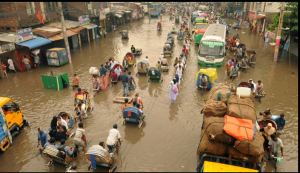Bangladesh will be one of the most-affected countries in South Asia by an expected 2°C rise in the world’s average temperatures in the next decades, according to a new scientific report released by the World Bank Group on Wednesday. It says the global warming will accelerate the sea-level rise and more extreme heat and more intense cyclones threatening food production, livelihoods, and infrastructure as well as slowing the poverty reduction in Bangladesh.
The report reveals that Bangladesh is one of more ‘potential impact hotspots’ threatened by extreme river floods, more intense tropical cyclones, sea-level rise and very high temperatures.
Cyclone Sidr exposed 3.45 million households to inundation. Cyclones in 2050 could expose 9.7 million people to more than 3 meters of inundation affecting agriculture and lives.
Depicting life in a not-too-distant future shaped by already present warming trends, the report warns that even 20 to 30 years from now, shifting rain patterns could leave some areas under water and others without enough water for power generation, irrigation or drinking. South Asia is already experiencing a warming climate.
“Bangladesh faces particularly severe challenges with climate change threatening its impressive progress in overcoming poverty,” said Johannes Zutt, World Bank Country Director for Bangladesh and Nepal.
He said Bangladesh has demonstrated itself as a leader in moving the climate change agenda forward. The World Bank is providing support to enhance the country’s resilience to climate change impacts through adaptation interventions and better disaster preparedness.
The report, prepared for the World Bank by the Potsdam Institute for Climate Impact Research and Climate Analytics and peer reviewed by 90 scientists worldwide, says the consequences for South Asia of a warming climate are even worse if global temperatures increased by an average of 4°C by 2090.
In this scenario, seen as likely unless action is taken now to limit carbon release in the atmosphere, South Asia would suffer more extreme droughts and floods, rising sea levels, melting glaciers, and declines in food production. For example, flood areas could increase by as much as 29 percent for a 2.5° C in Bangladesh.
A warming climate will contribute to slowing the reduction in poverty. While the lives of everyone in the region will be altered by climate change, the impacts of progressive global warming will fall hardest on the poor. Low crop yields and associated income loss from agriculture will continue the trend toward migration from rural to urban centers.
In Bangladesh, 40 percent of productive land is projected to be lost in the southern region of Bangladesh for a 65cm sea level rise by the 2080s.
About 20 million people in the coastal areas of Bangladesh are already affected by salinity in drinking water. Rising sea levels and more intense cyclones and storm surges could intensify the contamination of groundwater and surface water causing more diarrhea outbreaks, the report says. (Source: UNB)




